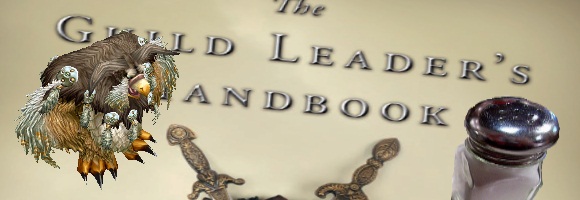
“Because it takes a village to slay a dragon.”
You might look askance at me for getting excited about that sentence. I wouldn’t blame you. It’s the blurb on the back of the Scott F. Andrew’s Guild Leader’s Handbook.
I admit I got quite excited when the opportunity to get a copy crossed my inbox. I’ve been involved in leading online communities in games for near on 10 years now, but I know I’m still learning about leadership and communities all the time; the nature of the games and roles within them is one of constant change. I figured that I might well learn from Andrews’ book and at the least it’d be an interesting read.
I know Lodur’s already shared his thoughts on it here but I’m going to, too. Not because I know Scott Andrews (I’m not affiliated with him or WoW.com in any way, convoluted or otherwise) but because if you visit this site you and I may well have something in common: an interest in guild leadership. And if that’s the case, you could do with getting yourself a copy of this book. And, to be on the safe side, a pinch of salt.
First and foremost I must salute Andrews. Guild or online leadership is a topic which many people would consider frivolous; Andrews approaches it with the solemnity and respect it deserves. His writing style manages to convey that all the way through the book.
At every turn we’re reminded – no really, guild leading is Serious Business, no joke. Players are real people: so are you. That’s something I respect and it’s something I’m continually harping on about as a misunderstood fact of online communities. Another tune I regularly pluck is that these games are meant to be fun – again, Andrews keeps ‘fun’ as one of the integral principles throughout the book, constantly reminding his readers that having fun is one of the main aims for both themselves and their charges in the communities they’re building.
Saying that, his writing style isn’t *too* serious. The Handbook’s very readable thanks to a style which flows well, explains concepts immediately and simply, and gets to the point in short and understandable sentences. In this way the Handbook is very accessible to anyone from new or prospective guild leader to old hand, or even a player with no intention of leading. Andrews also cross-references his material between sections, enabling you to flick back and forth as your interest takes you.
The Handbook’s carefully thought out sub-sections also aids its accessibility – they help split up the text, as do the regular diagrams and tables dotted throughout the book neatly reinforce his points. All of this helps Andrews to mint his topic as one not to be snorted at.
As to the material itself – there’s no doubt that Andrews is a veteran of leading online communities. I was impressed right from the introduction as Andrews goes straight for the jugular, calmly asserting the dichotomic challenge that guilds pose for their leaders. After all, guilds may be part of a virtual or ‘unreal’ realm but they are populated by real people, whom, as Andrews points out, guild leaders can’t physically see. I’d not often considered this or its ramifications before, but he’s right – not being able to see your members face to face, and able to gauge whether their body language is trying to tell you something, or if they’re only smiling with their mouth – these are things which make online leadership at once both more personal and more impersonal. As Andrews rightly recognises – a unique challenge, but not one impossible to get right.
There’s a lot of his wisdom I both like and wholeheartedly agree with. As a bit of a ruffled-feathers veteran myself I recognise that I – and others – can become entrenched in views on the game, playstyles and player expectations. So I was pleasantly relieved to see that Andrews expertly manages to keep an objective and unbiased voice throughout. His comparison of the machinations of guilds of different sizes is well explained – but then he moves on to a potentially volatile definition – that of ‘hardcore’ and ‘casual’. I’d disagree to some extent with his definitions – by his definition my own Kingslayer raiding group would be casuals – but the topic’s a good example of where he manages to tread a minefield without putting a foot wrong.
Andrews successfully illustrates most of his points with examples. He talks about player types and gives examples of how different types might interact. Crucially he also underlines the fact that players – again, as real people – aren’t as simple as to be a single player type, but rather composites. It might have been easy to forego this point in the name of generalisation: happily Andrews notes it. It’s a good example of little details that guild leaders have to watch out for and which might not cross our minds until it’s pointed out, possibly quite sharply. The Handbook rescues us from being thrown in at the deep end in numerous murky ponds.
Saying that, there are a few points where Andrews’ advice appears clunky. When talking about how to prepare for raids as a raid leader he basically recommends that one tell the group everything about the fight. Personally I’ve found that breaking down a fight into what each role (tanks, healers, DPSers) need to know is popular both in my active raid group and PUGs. In my opinion dumping all the information on people just drowns them in it, but giving them the bit that pertains to them makes it bite-size. He then goes on to talk about the importance of morale and constructive communication in post-combat raid leading, which I thoroughly agree with.
My biggest qualm with the Handbook is that it generalises a tad much. Sure, Andrews is presenting a guide applicable to all types of communities in all types of MMOs – he has to generalise a bit. But if you’re using the book in relation to a specific game you may well need a pinch of salt. For example, Andrews’ recommendation to be recruit by going out among strangers and recruiting is all very well and good, and worked brilliantly for me in WoW a year ago. Nowadays if you showcase your leadership abilities in a LFD PUG in WoW many people will think you’re being weird or pushy – and tell you that. Regardless of peoples’ reactions to a stranger from another server being social at them, the game simply doesn’t facilitate re-grouping with prospective recruits cross-server at present.
He also goes into some depth about the differences between raid and guild leading. This is the only time that I wholly disagreed with his expertise. He suggests raid leading and guild leading are a completely different kettle of fish (who puts fish in a kettle anyway?); in the former role you need to be prepared to shout at your raiders. Whether it’s due to different experiences or just his need to generalise, in my opinion Andrews’ wisdom fails him here, as my Kingslayer group stands as at least one example of a raiding style which succeeds at endgame content without screaming at or chewing over my raiders, which he seems to suggest all raid leaders will have to be prepared to do. If this is what he meant I believe him wrong – if not, I believe the text misleading. I’d quite like to hear Andrews’ take on that!
All in all, sodium chloride taken into consideration, I think Andrews’ book is a timely addition to the MMO world – and to my own bookshelf. His closing thoughts are as grounded as his opening ones and underline the fact that MMOs are a reality; whether or not individual MMOs can keep up or fall by the wayside, MMOs as a genre will be around for a long while. They provide something for us as players – the chance to partake in, create and resolve conflict situations – which ties them, as a platform, to us as real individuals.
Lodur gave publication details for the Handbook in his post but just in case you missed them;
The Handbook retails for $24.95 US ($31.95 CDN). It can be purchased directly through the publisher’s website.

